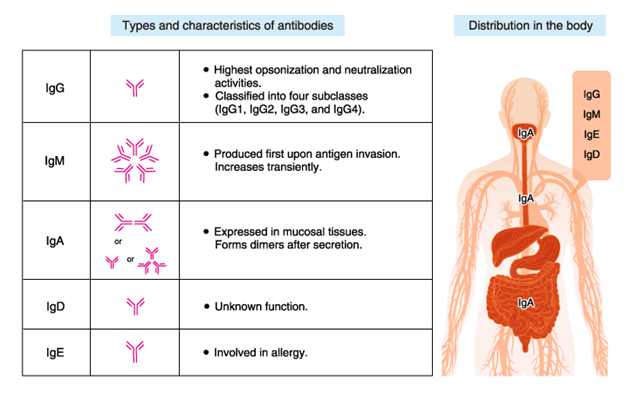The antibody class involved in hypersensitivity reaction Type I is:
IgE
IgA
IgG
IgM
The Correct Answer is A
A. IgE (Immunoglobulin E): This class of antibodies is primarily involved in hypersensitivity reactions Type I, which are immediate allergic reactions. When a person is exposed to an allergen they are sensitive to, IgE antibodies on the surface of mast cells and basophils bind to the allergen. This triggers the release of inflammatory mediators like histamine, leading to allergic symptoms such as itching, hives, and in severe cases, anaphylaxis.
B. IgA (Immunoglobulin A): IgA antibodies are primarily found in mucosal areas such as the respiratory and gastrointestinal tracts. They play a role in immune defense on mucosal surfaces and are important for preventing infections. While IgA is not directly associated with hypersensitivity reactions Type I, deficiencies in IgA can sometimes lead to increased susceptibility to certain infections.
C. IgG (Immunoglobulin G): IgG antibodies are the most common type of antibody in the bloodstream and are involved in various immune responses, including defense against bacterial and viral infections. IgG antibodies are not specific to Type I hypersensitivity reactions; they are part of the immune system's broader defense mechanisms.
D. IgM (Immunoglobulin M): IgM antibodies are the first antibodies to be produced in response to an infection. They are large pentameric molecules and are effective at agglutinating pathogens. IgM antibodies are involved in the primary immune response to infections, but they are not specifically associated with Type I hypersensitivity reactions.

Nursing Test Bank
Naxlex Comprehensive Predictor Exams
Related Questions
Correct Answer is A
Explanation
A. "This drug has a longer duration of action than some of the other antibiotics."
Explanation: Azithromycin, a macrolide antibiotic, has a longer half-life in the body compared to some other antibiotics. Half-life refers to the time it takes for half of the drug to be eliminated from the body. A longer half-life means the drug remains effective for a longer duration, allowing for less frequent dosing.
B. "This is a much more effective drug than what you received previously."
Explanation: While azithromycin is effective against a wide range of bacterial infections, it's not accurate to say it's universally more effective than other antibiotics. The choice of antibiotic depends on the specific type of infection and the susceptibility of the bacteria causing it. Effectiveness varies based on the context of use.
C. "I'll call the pharmacy and ask about the chemical makeup of the drug."
Explanation: While understanding the chemical makeup of drugs is important for healthcare professionals, it might not directly answer the patient's question about the dosing frequency. Explaining the drug's pharmacological properties, such as its duration of action, would provide a more relevant and understandable response to the patient's query.
D. "You'll need to ask your healthcare provider questions like that."
Explanation: This response does not provide the patient with the information they seek. Nurses are valuable resources for medication-related questions and should strive to provide accurate and understandable explanations to patients.
Correct Answer is A
Explanation
A. Discoloration of teeth: Tetracycline antibiotics can bind with calcium ions in teeth, leading to the development of yellow-gray-brown stains. This effect is particularly significant in developing teeth in children below the age of 8 and can result in permanent discoloration.
B. Anabolic change: This term doesn't specifically relate to the side effects of tetracycline. "Anabolic" generally refers to processes in the body that build up complex molecules from simpler ones. There's no direct connection between tetracycline and anabolic changes.
C. Cartilage damage: Tetracyclines, especially in high doses or with prolonged use, have been associated with potential adverse effects on cartilage. This is more relevant in individuals whose bones and cartilage are still growing, such as children. It can interfere with skeletal development.
D. Suppression of growth: Long-term use of tetracycline in children can interfere with bone growth and development. It can suppress the growth of bones and affect overall height. This is a significant concern when considering the use of tetracycline in pediatric patients.
Whether you are a student looking to ace your exams or a practicing nurse seeking to enhance your expertise , our nursing education contents will empower you with the confidence and competence to make a difference in the lives of patients and become a respected leader in the healthcare field.
Visit Naxlex, invest in your future and unlock endless possibilities with our unparalleled nursing education contents today
Report Wrong Answer on the Current Question
Do you disagree with the answer? If yes, what is your expected answer? Explain.
Kindly be descriptive with the issue you are facing.
